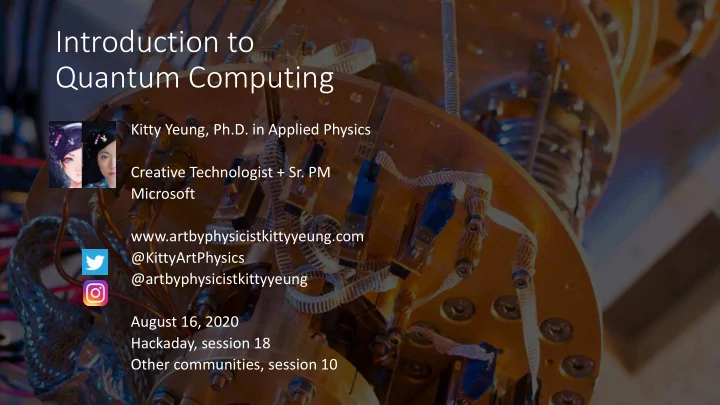

Introduction to Quantum Computing Kitty Yeung, Ph.D. in Applied Physics Creative Technologist + Sr. PM Microsoft www.artbyphysicistkittyyeung.com @KittyArtPhysics @artbyphysicistkittyyeung August 16, 2020 Hackaday, session 18 Other communities, session 10
Class structure • Comics on Hackaday – Quantum Computing through Comics every Sun • 30 mins – 1 hour every Sun, one concept (theory, hardware, programming), Q&A • Contribute to Q# documentation http://docs.microsoft.com/quantum • Coding through Quantum Katas https://github.com/Microsoft/QuantumKatas/ • Discuss in Hackaday project comments throughout the week • Take notes
RSA Numbers • https://en.wikipedia.org/wiki/RSA_numbers • RSA-100 has 100 decimal digits (330 bits). Its factorization was announced on April 1, 1991 by Arjen K. Lenstra. Reportedly, the factorization took a few days using the multiple-polynomial quadratic sieve algorithm on a MasPar parallel computer. • RSA-100 = N = 152260502792253336053561837813263742971806811496138068865790849458012296325895 2897654000350692006139 • RSA-100 = p x q= 37975227936943673922808872755445627854565536638199 × 40094690950920881030683735292761468389214899724061 • Number of qubits needed ~ 659 + 329 = 988 (not considering error-correction qubits)
Let’s use a (much) smaller number • N = 35 = p * q • Number of qubits needed = 11, so that 2 11 = 2048 > 𝑂 2 = 35 2 = 1225
Let’s use a (much) smaller number • N = 35 = p * q • Number of qubits needed = 11, so that 2 11 = 2048 > 𝑂 2 = 35 2 = 1225 Periodicity 𝑠 = 12 𝑏 0 𝑁 od 𝑂 = 3 0 𝑁 od 35 = 𝑏 𝑠 𝑁 od 𝑂 = 3 12 𝑁 od 35 = 1 𝑏 𝑠 -1 should be divisible by N
Pure math • Rearrange: ( 𝑏 𝑠 /2 ) 2 -1 should be divisible by N • ( 𝑏 𝑠 /2 -1) ( 𝑏 𝑠 /2 +1) should be divisible by N • 𝑠 needs to be even, ( 𝑏 𝑠 /2 +1) and ( 𝑏 𝑠 /2 -1) are not individually divisible by N • p divides ( 𝑏 𝑠 /2 -1) = 728, q divides ( 𝑏 𝑠 /2 +1) = 730 • p = GCD(N, ( 𝑏 𝑠 /2 -1) ) = GCD(35,728) = 7 • q = GCD(N, ( 𝑏 𝑠 /2 +1) ) = GCD(35,730) = 5 A different proof: How Quantum Computers Break Encryption | Shor's Algorithm Explained https://www.youtube.com/watch?v=lvTqbM5Dq4Q
Euclidean algorithm • p = GCD(N, ( 𝑏 𝑠 /2 -1) ) = GCD(35,728) = 7 • q = GCD(N, ( 𝑏 𝑠 /2 +1) ) = GCD(35,730) = 5 • 728-35 = 693 divisible by 7 • 693-35 = 658 divisible by 7 • … • 63-35 = 28 divisible by 7
Quantum part • Hard step is finding 𝑠 for large N
1. Quantum Computation and Quantum Information - 10th Anniversary Edition, Nielsen and Chuang 2. https://github.com/Michaelvll/myQShor CS251 Quantum Information Science, 2018 @ ACM Honors Class, SJTU
Quantum Computation and Quantum Information - 10th Anniversary Edition, Nielsen and Chuang
Quantum Computation and Quantum Information - 10th Anniversary Edition, Nielsen and Chuang
Q# sample • microsoft/Quantum : Samples and tools to help get started with the Quantum Development Kit. • Samples>algorithms>integer-factorization • Numerics Library: Microsoft.Quantum.Arithmetic; • QFT: Microsoft.Quantum.Canon
• Post in chat or on Hackaday project https://hackaday.io/project/168554-quantum-computing-through-comics Questions • FAQ: Past Recordings on Hackaday project or my YouTube https://www.youtube.com/c/DrKittyYeung • Next Sunday: quantum career Q&A session
Recommend
More recommend